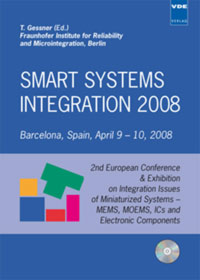Waferbond technologies and quality assessment
Conference: Smart Systems Integration 2008 - 2nd European Conference & Exhibition on Integration Issues of Miniaturized Systems - MOMS, MOEMS, ICS and Electronic Components
04/09/2008 - 04/10/2008 at Barcelona, Spain
Proceedings: Smart Systems Integration 2008
Pages: 8Language: englishTyp: PDF
Personal VDE Members are entitled to a 10% discount on this title
Authors:
Wiemer, Maik; Frömel, Jörg; Geßner, Thomas (Fraunhofer Institute Reliability and Microintegration, Department Multi Device Integration, Reichenhainer Strasse 88, 09126 Chemnitz, Germany)
Geßner, Thomas (Chemnitz University of Technology, Center for Microtechnologies Chemnitz, Reichenhainer Strasse 70, Germany)
Abstract:
A well established technology for the fabrication of 3D devices is wafer bonding. Several technologies like direct and anodic bonding without intermediate layer or thermocompression wafer bonding with intermediate layers like low melting frit glasses, eutectic materials or polymers were developed during the last years and are nowadays extensively used in industrial applications. Within the paper we will address some important aspects of the different bonding techniques like substrate requirement, treatments for the modification of material surfaces, various bonding methods as well as some quality aspects. The main method to evaluate the bond strength is the micro chevron test. This test requires special designed test samples and is destructive. For anodic bonding between transparent glass and silicon a non destructive bond strength test structure can be used. This non-destructive test structure based on structure fabricated on one surface of the bond. The leak tightness can be tested by using the standard He leak test, if low requirements to the leakage rate exist or with the help of a resonant structure inside of the cavity if a very low leakage rate should be controlled.


